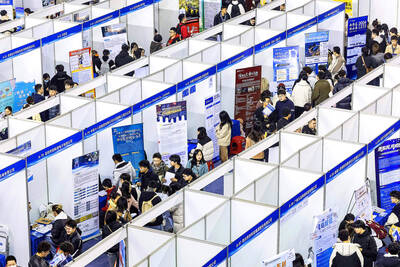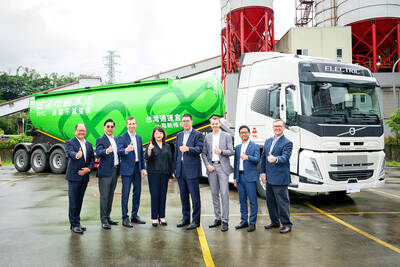Shipbuilder CSBC Corp Taiwan (台灣國際造船) yesterday launched construction of the nation’s first domestic crane vessel — the Green Jade — after inking an early work agreement with CSBC-DEME Wind Engineering Co (台船環海).
CSBC-DEME is a joint venture between CSBC and Belgium’s Dredging, Environmental and Marine Engineering NV.
The Green Jade, scheduled to be completed by the end of 2022, would enable CSBC-DEME to carry out engineering, procurement, construction and installation services for the offshore wind energy industry.
The 216.5m vessel is to be equipped with a 4,000-tonne crane, as well as a class-3 dynamite positioning system, CSBC said.
The Green Jade would carry multiple foundation piles and other turbine components per trip while housing up to 160 crew members, it said.
CSBC-DEME plans to use the vessel to provide services to the Hai Long (海龍) offshore wind farm project off the coast of Changhua County, which is being codeveloped by Northland Power Inc, Yushan Energy Pte (玉山能源) and Mitsui & Co Ltd.
The vessel would also help transport and install submarine foundations and wind turbines for the Chong Neng (中能) wind farm project off Changhua codeveloped by China Steel Corp (中鋼) and Copenhagen Infrastructure Partners K/S.
In related news, Germany-based Wpd AG on Wednesday announced that it has inked an agreement with Taiwan Green Power Co Ltd (台灣綠電), a subsidiary of Lealea Group (力麗集團), to jointly develop offshore wind farm site No. 28 off Changhua.
The project, which is expected to be part of a third tender round scheduled for the second half of this year, would have an installed capacity of up to 600 megawatts (MW).
Wpd has sold a 25 percent stake in its 640MW offshore wind farm near Yunlin County to Thailand-based independent power producer Thai Electricity Generating Public Co Ltd.
The company did not disclose the money amount.
Wpd, which is heading another 350MW wind project off the coast of Taoyuan scheduled for commissioning by 2022, is in the process of signing supply agreement while awaiting the financial closure, likely in the fourth quarter of this year.

Stephen Garrett, a 27-year-old graduate student, always thought he would study in China, but first the country’s restrictive COVID-19 policies made it nearly impossible and now he has other concerns. The cost is one deterrent, but Garrett is more worried about restrictions on academic freedom and the personal risk of being stranded in China. He is not alone. Only about 700 American students are studying at Chinese universities, down from a peak of nearly 25,000 a decade ago, while there are nearly 300,000 Chinese students at US schools. Some young Americans are discouraged from investing their time in China by what they see

MAJOR DROP: CEO Tim Cook, who is visiting Hanoi, pledged the firm was committed to Vietnam after its smartphone shipments declined 9.6% annually in the first quarter Apple Inc yesterday said it would increase spending on suppliers in Vietnam, a key production hub, as CEO Tim Cook arrived in the country for a two-day visit. The iPhone maker announced the news in a statement on its Web site, but gave no details of how much it would spend or where the money would go. Cook is expected to meet programmers, content creators and students during his visit, online newspaper VnExpress reported. The visit comes as US President Joe Biden’s administration seeks to ramp up Vietnam’s role in the global tech supply chain to reduce the US’ dependence on China. Images on

Taiwan Transport and Storage Corp (TTS, 台灣通運倉儲) yesterday unveiled its first electric tractor unit — manufactured by Volvo Trucks — in a ceremony in Taipei, and said the unit would soon be used to transport cement produced by Taiwan Cement Corp (TCC, 台灣水泥). Both TTS and TCC belong to TCC International Holdings Ltd (台泥國際集團). With the electric tractor unit, the Taipei-based cement firm would become the first in Taiwan to use electric vehicles to transport construction materials. TTS chairman Koo Kung-yi (辜公怡), Volvo Trucks vice president of sales and marketing Johan Selven, TCC president Roman Cheng (程耀輝) and Taikoo Motors Group

New apartments in Taiwan’s major cities are getting smaller, while old apartments are increasingly occupied by older people, many of whom live alone, government data showed. The phenomenon has to do with sharpening unaffordable property prices and an aging population, property brokers said. Apartments with one bedroom that are two years old or older have gained a noticeable presence in the nation’s six special municipalities as well as Hsinchu county and city in the past five years, Evertrust Rehouse Co (永慶房產集團) found, citing data from the government’s real-price transaction platform. In Taipei, apartments with one bedroom accounted for 19 percent of deals last